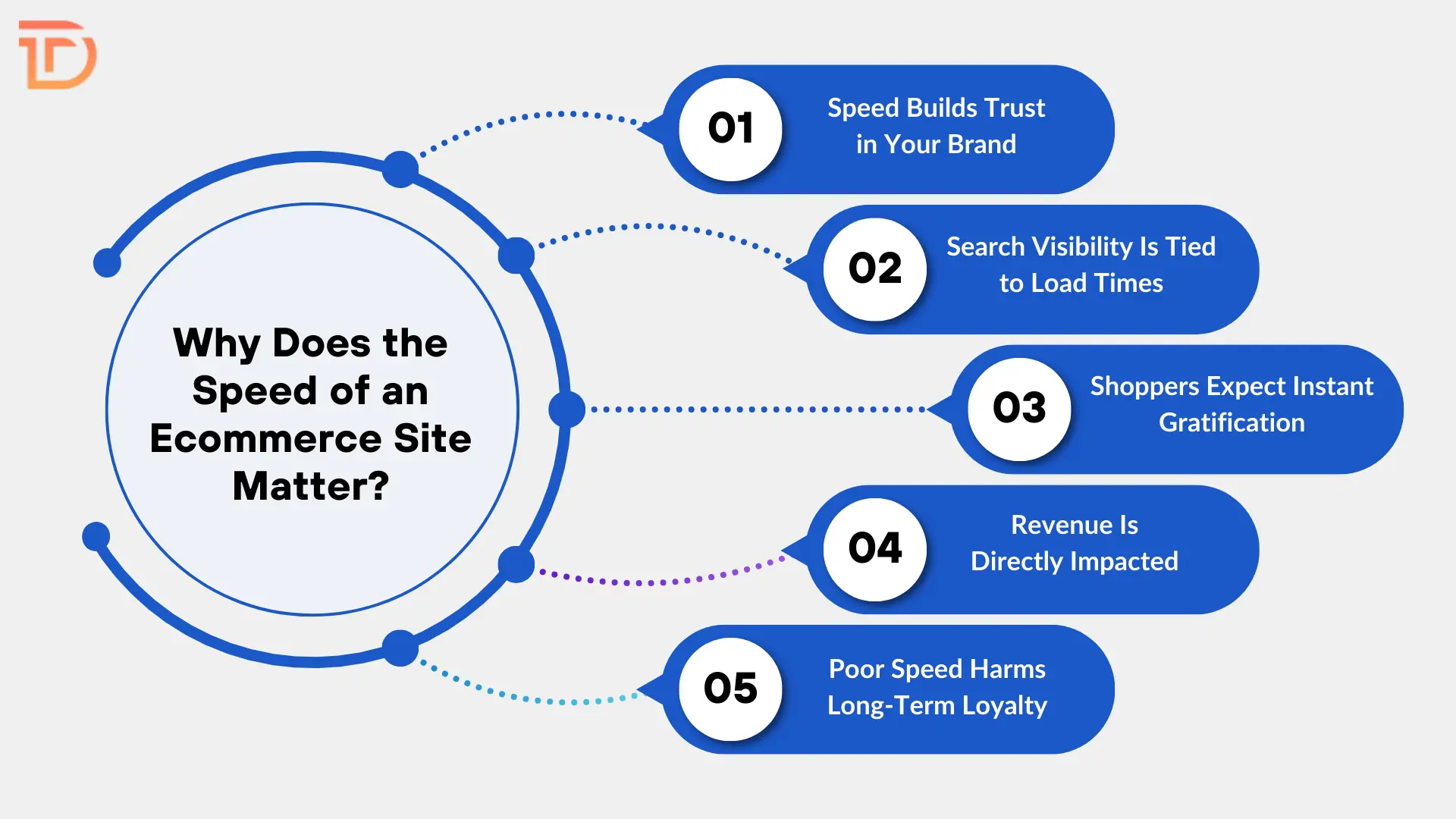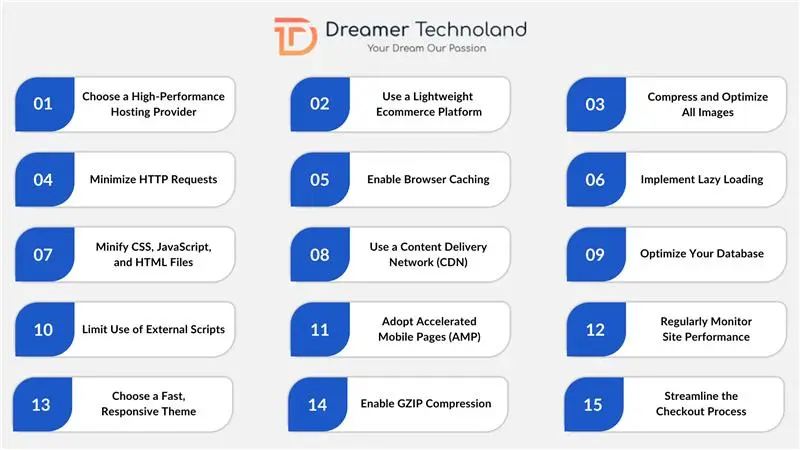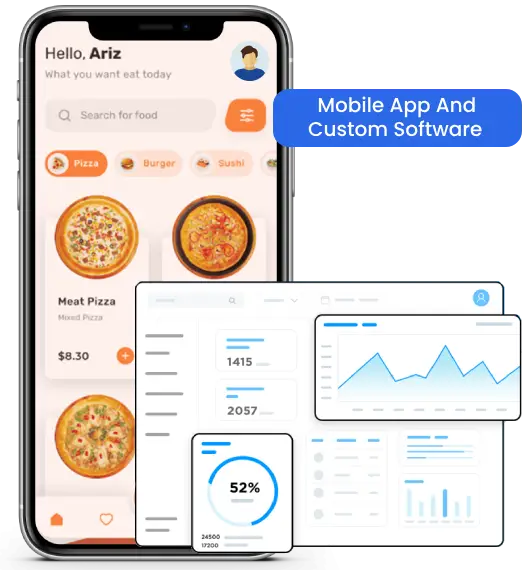Online shoppers have grown impatient in the past few years. With so many choices available at their fingertips, even a delay of a few seconds can send them to a competitor. Ecommerce has revolutionized how people shop, but it has also raised expectations. Customers want speed, efficiency, and convenience. A sluggish website not only frustrates users but also hurts the credibility and revenue of an online store. Improving the speed and overall performance of an ecommerce site is an absolute necessity in the modern era. Whether you’re running a small online boutique or a multi-category marketplace, performance optimization plays a crucial role in shaping the user experience and determining your business success. In this blog, we’ll explore what ecommerce site performance optimization is, why speed matters for your online store, and the fifteen most effective ways to make your ecommerce site faster.
What is Ecommerce Site Performance Optimization?
Performance optimization refers to a series of strategic improvements aimed at making an ecommerce website load faster, run more smoothly, and handle user interactions more efficiently. It involves technical tweaks, design adjustments, server enhancements, and content delivery improvements that collectively contribute to a seamless online shopping experience.
Every second counts in ecommerce. The faster your site loads, the more likely visitors are to stick around, explore your products, and complete a purchase. Optimization ensures that every element of your websites such as images, scripts, plugins, product pages, and payment gateways operates with maximum efficiency.
Optimization also enhances your site’s compatibility with mobile devices, search engines, and third-party tools. As the ecommerce landscape becomes increasingly competitive, fine-tuning your website for peak performance gives you a significant edge.
Global Ecommerce Market Insights for 2025
The global e-commerce market continues its impressive growth trajectory, with projections indicating a substantial increase in both market size and user penetration in the coming years. According to a report by Statista, the global ecommerce market was valued at approximately $25.93 trillion in 2023 and is projected to reach $83.26 trillion by 2030, reflecting a compound annual growth rate (CAGR) of 18.9%. The growth is fueled by a burgeoning number of online shoppers, which is expected to climb from 2.71 billion in 2024 to 2.77 billion in 2025. Mobile commerce is a significant driver of this expansion, with sales projected to hit $728.28 billion by 2025, and smartphones are expected to account for over 60% of these sales. Key product categories leading this online retail revolution include consumer electronics, fashion and apparel, and food and beverages, with consumer electronics alone projected to reach $922.5 billion in spending by 2025. Regionally, North America held the largest market share in 2023, but the Asia-Pacific market is the fastest-growing. The sheer volume of online retail is also on the rise, with online sales expected to constitute 21% of all global retail sales in 2025. The significance of this growth becomes even clearer when considering that the B2B e-commerce segment held the largest market share in 2023, accounting for approximately 70%.
Why Does the Speed of an Ecommerce Site Matter?
Speed goes beyond a technical metric. It directly shapes how users experience your ecommerce site. With fierce online competition and short attention spans, instant response to every click and scroll is essential. Speed often determines whether visitors convert or turn to competitors. The following are reasons why site speed plays such a crucial role in the success of your ecommerce business:

Speed Builds Trust in Your Brand
A fast site feels professional, secure, and reliable. Visitors subconsciously associate website performance with the credibility of the business behind it. A laggy site feels neglected and can raise concerns about the reliability of service, shipping, and even payment security.
Search Visibility Is Tied to Load Times
Major search engines like Google and Bing prioritize speed when ranking websites. A slow ecommerce site may struggle to rank on the first page of search results. This limits your organic reach and increases dependency on paid ads.
Shoppers Expect Instant Gratification
Modern online consumers have grown used to lightning-fast interactions. They expect product pages to load in seconds and checkout processes to be smooth and instant. A delay of even three seconds can lead to page abandonment, drastically lowering your chances of conversion.
Revenue Is Directly Impacted
Research consistently shows that faster sites convert better. A one-second delay in page load time can reduce conversions by up to 7 percent. A slow site is not just losing customers; it is losing revenue with every passing second.
Poor Speed Harms Long-Term Loyalty:
Customer retention depends on experience. If users encounter slow loading speeds during their first visit, they are less likely to return. This hurts customer lifetime value and weakens your ability to grow a loyal customer base over time.
How Does Speed Affect an Ecommerce Site’s Performance?
Website speed influences the entire ecommerce experience, not just first impressions. From product search to checkout, every feature relies on fast, seamless interactions. A slow site frustrates users, harming engagement and business results. Here’s how speed directly impacts your ecommerce website’s performance:
User Engagement Increases with Speed
A faster website allows users to move through the site effortlessly. Smooth browsing encourages them to view more products, read descriptions, and explore related categories. When users feel in control, they naturally stay longer and interact more.
Higher Average Order Values Become Possible
When customers are not distracted by slow page loads, they spend more time discovering add-on products and promotions. This often leads to larger carts and increased order values, simply because the site performance made the experience enjoyable.
Quick Checkout Processes Lead to More Completed Sales:
A sluggish checkout experience is one of the top reasons for cart abandonment. Speed ensures that each step, from selecting a shipping option to entering payment details, happens without lag or error. This improves the number of completed purchases.
Interactive Features Respond Seamlessly
Site elements like image zoom, size selectors, product filters, and customer reviews rely on speed to function correctly. If these features respond slowly or fail to load, it compromises the user experience and reduces the effectiveness of your product presentation.
High Traffic Can Be Managed Efficiently
Ecommerce sites often experience spikes in traffic during flash sales, promotions, or seasonal events. A well-optimized, high-speed website can absorb the pressure without crashing or slowing down. This ensures a consistent user experience even during periods of high demand.
15 Best Ways to Speed Up Your Ecommerce Site
Implementing proven strategies can dramatically enhance the speed and efficiency of your ecommerce website. The following are fifteen effective tips to achieve optimal performance.

Choose a High-Performance Hosting Provider
Your hosting service plays a critical role in determining how fast your ecommerce site loads. Select a provider that offers SSD storage, dedicated resources, and built-in CDN integration. Scalable infrastructure helps your store handle sudden traffic spikes, ensuring consistent performance even during peak shopping seasons or flash sale events.
Use a Lightweight Ecommerce Platform
A streamlined platform minimizes bloat and helps your store operate more efficiently. Choose an ecommerce solution that allows essential features without overloading your site with unnecessary code. Lightweight platforms reduce loading times, increase responsiveness, and make it easier to implement future optimizations without affecting core functionality.
Compress and Optimize All Images
High-resolution images can significantly slow down your website. Compress every image using tools like TinyPNG or ImageOptim, and always use the right format for the image type. Implement responsive image techniques to ensure the smallest possible file size is served to users based on their device, which accelerates load times across platforms.
Minimize HTTP Requests
Every component on a webpage, including images, stylesheets, and scripts, triggers an HTTP request. Too many requests slow down your site. Reduce them by combining CSS and JavaScript files, eliminating unnecessary plugins, and using CSS sprites for icons. Fewer requests lead to faster rendering and a smoother browsing experience.
Enable Browser Caching
Caching allows browsers to store parts of your site locally, so returning visitors don’t have to reload everything from scratch. Set up proper expiration headers for static assets such as images, styles, and scripts. This significantly reduces page load time and provides a faster experience for repeat users on any device.
Implement Lazy Loading
Lazy loading ensures images and other media only load when users scroll to them. This technique speeds up initial page rendering by loading just the visible content first. As users scroll down, additional elements load progressively. It’s especially useful on product listing pages, galleries, and blogs with lots of visual content.
Minify CSS, JavaScript, and HTML Files
Code minification removes unnecessary characters, comments, and whitespace from files. This reduces file size and shortens load times. Tools like UglifyJS, CSSNano, or HTMLMinifier can automate this process. Smaller, leaner files improve site responsiveness and reduce the time it takes for browsers to render your pages.
Use a Content Delivery Network (CDN)
A CDN stores copies of your site on multiple servers across various geographic locations. When a user visits your site, content is delivered from the nearest server, reducing latency. CDNs are especially helpful for global ecommerce businesses that need consistent speed across countries and regions, regardless of user location.
Optimize Your Database
Over time, databases collect clutter such as post revisions, spam comments, and unused entries. Regularly clean and optimize your database to keep query times low. Indexing frequently used columns, deleting orphaned data, and running periodic optimizations ensure your backend performs efficiently and supports faster frontend operations.
Limit Use of External Scripts
Third-party scripts like ad trackers, chat widgets, and social buttons can slow down your site if not handled properly. Only include essential external scripts and load them asynchronously when possible. Avoid blocking scripts that delay the rendering of your page and monitor their performance through speed testing tools.
Adopt Accelerated Mobile Pages (AMP)
AMP is designed to make web content load almost instantly on mobile devices. By stripping down pages to their essential components, AMP ensures that mobile shoppers experience fast, lightweight pages. Implementing AMP for product pages and blog content can lead to improved mobile engagement, higher rankings, and reduced bounce rates.
Regularly Monitor Site Performance
Monitoring tools provide valuable insights into how your site performs in real time. Use platforms like GTmetrix, Google PageSpeed Insights, or Lighthouse to detect speed bottlenecks. Regular assessments allow you to catch emerging issues before they affect user experience, keeping your ecommerce store running smoothly and efficiently.
Choose a Fast, Responsive Theme
A theme designed with speed in mind will have clean code, minimal external dependencies, and optimized layouts for all devices. Avoid overly complex themes with excessive animations or bloated frameworks. Instead, opt for one that is lightweight, mobile-friendly, and built to adapt across screen sizes without sacrificing performance.
Enable GZIP Compression
GZIP compression reduces the size of HTML, CSS, and JavaScript files before sending them to the browser. Smaller files mean faster downloads and reduced bandwidth usage. Enabling GZIP on your server helps improve loading speed across all devices and browsers, especially for users on slower internet connections.
Streamline the Checkout Process
Complicated checkouts lead to cart abandonment. Simplify your checkout flow by reducing the number of steps, using autofill features, and eliminating unnecessary fields. Offer guest checkout options and provide clear progress indicators. A fast, hassle-free checkout experience encourages users to complete their purchases without second thoughts.
Wrapping Up
Performance optimization for an ecommerce site is not a one-time fix. It is a continuous effort to deliver a better shopping experience. A fast-loading website does more than just please visitors. It enhances brand trust, boosts SEO rankings, and increases conversions. Implementing even a handful of the above techniques can yield immediate improvements in site speed and customer retention. With the ecommerce space growing more competitive by the day, maintaining top-notch performance is one of the best investments any online store can make.
Dreamer Technoland specializes in building fast, secure, and scalable ecommerce solutions tailored to your business goals. Whether you need a new ecommerce site built from scratch, a mobile app to extend your reach, or want to optimize an existing platform, our team of experts delivers results that drive engagement and boost sales. We provide custom ecommerce app development services alongside performance optimization, custom development, and ongoing maintenance to give your online store the speed, functionality, and flexibility it deserves.
Related Articles to Ecommerce App Development
- How to Increase Your E-Store’s Revenue?
- Voice Commerce & Social Shopping: Building the Next Gen E‑commerce App
- Role of Ecommerce Mobile Apps in Shaping Modern Retail Strategies
- 10 Things to Consider When Building an Ecommerce Website
- What Are the Different Types of Ecommerce Applications?
- Top 5 Technologies for Building Ecommerce Platforms
- B2B eCommerce Platform Software Development Cost







